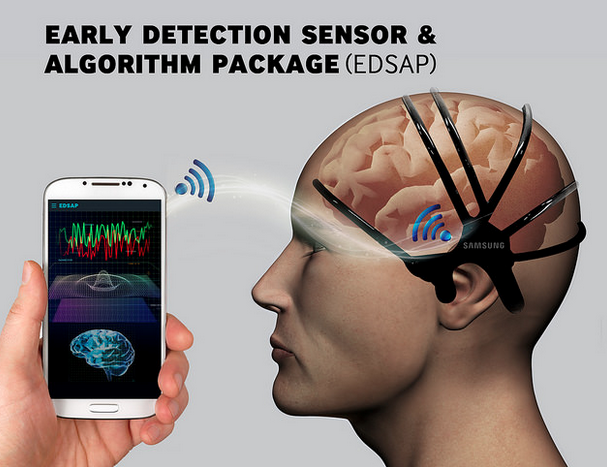Engineers from Samsung develop an Early Detection Sensor and Algorithm Package (EDSAP) to predict stroke events faster, and with increased accuracy.
Medical innovation sometimes comes from the least expected places—like your washing machine.
Samsung engineers who normally work on washing machines and smartphones recently took over the company’s Creativity Lab with an innovative idea that few people thought would work. Despite these odds, they created a prototype for a wearable sensor capable of monitoring brainwaves for early signs of stroke.
When the Samsung team approached neurologists with the idea of detecting pending strokes by monitoring brainwaves, there was some skepticism.
“We approached neurologists, asking them whether this was feasible,” said Se-hoon Lim, the project lead. “They were dismissive, but we wanted to give it a go. Health-related wearable devices are becoming more and more complex, meaning their capabilities are growing increasingly sophisticated.”
The prototype, called the Early Detection Sensor and Algorithm Package (EDSAP), includes a sensor-laden headset and a smartphone or tablet app programed with algorithms to analyze the signals and warn of a possible stroke. All this takes place within 60 seconds. This is significantly faster than the 15 minutes it takes current brainwave monitoring equipment to detect strokes at hospitals.

EDSAP - Source: Samsung Tomorrow (Flickr: CC)
Lim and his team incorporated a highly conductive, rubber-like material into the sensors. These sensors lead to highly detailed scans without the unpleasantness of saline hair rubs, which are required in traditional brain scans.
Move over Google Glass—it’s what we can’t see that matters.
The current prototype looks a bit like orthodontic headgear. Eventually, though, Lim thinks it might be possible to integrate the EDSAP scanning technology into everyday accessories, such as eyeglasses or hairpins. This would make constant monitoring less intrusive for patients with high stroke risks.
The EDSAP is also unique because of its algorithm. Combined with signal processing software and artificial intelligence, the EDSAP algorithm compares the scans to data collected from stroke patients to predict the likelihood of future events.
While the team has yet to perform full clinical trials on EDSAP, they are already considering other scans it might perform, such as electrocardiograms. EDSAP may also have use in mental health, for monitoring of stress and anxiety levels.
Health Disparities: Disproportionate Stroke Burdens and Healthcare Access May Limit EDSAP’s Global Scalability
Every two seconds, someone in the world has a stroke. A stroke is a medical emergency that occurs when something blocks the brain’s blood supply or when a blood vessel in the brain bursts. This damages the tissue in the brain, which can lead to disability or death.
Around the world, approximately 15 million people suffer strokes each year, according to the World Heart Federation. Stroke is the second leading cause of death, and second leading cause of disability.
Risk factors for stroke include the use of tobacco, alcohol abuse, high blood pressure, overweight/obesity, high cholesterol, diabetes, and a sedentary lifestyle. A full 80% of stroke risk factors are preventable, according to the World Health Organization.
The incidence of stroke is increasing in low and middle-income countries where resources are most constrained. By 2025, 4 of 5 stroke events are expected to be in these countries as urbanization and risk exposure increase, according to a Denmark study.
Although unproven, the speed and portability of Samsung’s EDSAP may hold promise for those at risk of stroke. Seeking treatment as early as possible during a stroke can limit its long-term effects and possibly prevent death. It seems, then, that wearing a monitor like this might help people recognize the need to seek medical attention rather than performing a quick Internet search of their symptoms.
Questions remain about its use in global health, however. It seems that those who might find this device affordable are those that have access to health care, and may know some of the early warning signs of stroke.
Getting a wearable stroke-detector to places in the world without the ICT infrastructure necessary to support them does not seem feasible at this time. But this Samsung team has heard that before.
Jenn Lonzer has a B.A. in English from Cleveland State University and an M.A. in Health Communication from Johns Hopkins University. Passionate about access to care and social justice issues, Jenn writes on global digital health developments, research, and trends. Follow Jenn on Twitter @jnnprater3.

